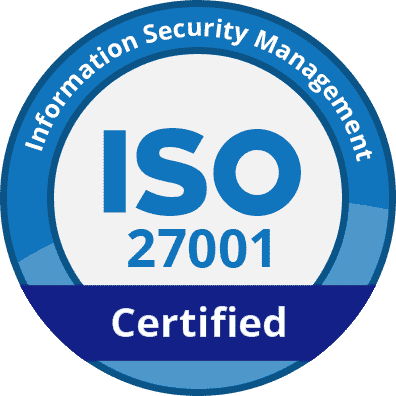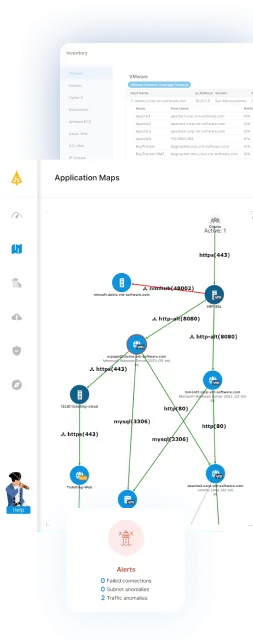What Is SSL Certificate Management?
SSL certificate management involves monitoring, managing, and automating the life cycle of SSL certificates. These certificates establish a secure, encrypted link between a server and a user’s browser, ensuring data integrity and privacy.
Management tasks include issuance, renewal, and revocation to maintain security operations. Management is necessary to prevent expired certificates, which can lead to service disruptions and security vulnerabilities. Having a structured management process is vital for organizations to maintain trust and compliance.
Managing SSL certificates manually can be overwhelming due to the extensive monitoring required for hundreds or thousands of certificates. An organized management system ensures certificates remain valid and updated, basic encryption protocols are followed, and any issues are addressed proactively. Automation tools ease these tasks for administrators.
Table of Contents
ToggleHow SSL Certificates Work
SSL certificates enable secure communication between a server and a client, typically a web browser. When a user accesses a website secured with SSL, the server sends its SSL certificate to the browser. This certificate contains the server’s public key, which the browser uses to verify the server’s identity and establish a secure connection.
The process begins with a handshake protocol where the server and client exchange cryptographic keys. The server presents its certificate, which is validated by the client using a chain of trust linked to a trusted certificate authority (CA). If the certificate is valid and trusted, the browser and server generate a session key for encrypting all subsequent communication.
This encrypted link ensures that sensitive data, such as login credentials or payment information, cannot be intercepted or tampered with during transmission. SSL certificates also authenticate the server’s identity, giving users confidence that they are communicating with the intended website, not a malicious impostor.
Types of SSL Certificates
SSL certificates come in various types, suited to different needs and levels of validation:
- Domain validation (DV) certificates: These verify only that the applicant owns the domain. They are quick and easy to obtain, making them suitable for small businesses or personal websites that do not handle sensitive data.
- Organization validation (OV) certificates: OV certificates involve a more thorough validation process, confirming the legitimacy of the organization behind the website. This type provides a higher level of trust, making it suitable for organizations and eCommerce platforms.
- Extended validation (EV) certificates: EV certificates require a rigorous vetting process to establish the organization’s identity and legal status. They provide the highest level of trust, displaying a green address bar or similar visual indicators in browsers. They are recommended for organizations handling sensitive transactions.
- Wildcard SSL certificates: These certificates secure a primary domain and all its subdomains (e.g., *.example.com). Wildcard certificates are cost-effective for organizations managing multiple subdomains under the same domain.
- Multi-domain SSL certificates (SAN): SAN certificates secure multiple domains under a single certificate. They are useful for organizations managing a diverse portfolio of websites or services.
- Self-signed certificates: Generated internally rather than issued by a trusted CA, these certificates are typically used for internal systems or testing environments. However, they are not trusted by public browsers, making them unsuitable for external-facing applications.
Challenges in Managing SSL Certificates
Organizations often face the following challenges when managing certificates
- Expiration and renewal: Certificates have a limited lifespan, typically between one to two years. Organizations must maintain an up-to-date inventory to track each certificate’s expiration date, ensuring timely renewals. Failure to renew before expiration can result in service disruptions, loss of functionality, and diminished customer trust due to insecure warnings displayed by browsers.
- Certificate sprawl: This occurs when the number of SSL certificates in use grows uncontrolled across an organization, which complicates tracking and management. This sprawl often arises from the decentralized issuance of certificates, leading to inconsistencies in renewal and security policies. A lack of centralized visibility increases the risk of some certificates being neglected, potentially leaving critical systems unprotected and exposing them to unauthorized access and other security vulnerabilities.
- Security risks of mismanagement: Expired or improperly configured certificates can be exploited by attackers to conduct man-in-the-middle attacks, intercepting sensitive data exchanged between clients and servers. Additionally, overlooked certificates can create unmonitored entry points for cybercriminals, increasing the organization’s vulnerability to attacks. Constant vigilance and regular audits are essential to mitigate these security risks.

Lanir specializes in founding new tech companies for Enterprise Software: Assemble and nurture a great team, Early stage funding to growth late stage, One design partner to hundreds of enterprise customers, MVP to Enterprise grade product, Low level kernel engineering to AI/ML and BigData, One advisory board to a long list of shareholders and board members of the worlds largest VCs
Tips from the Expert
In my experience, here are tips that can help you better manage SSL certificates effectively and securely:
- Establish ownership accountability: Assign clear ownership of SSL certificates within the organization. Each certificate should have a designated owner responsible for its monitoring, renewal, and compliance, ensuring accountability and reducing the risk of expired or unmanaged certificates.
- Implement certificate governance policies: Develop organization-wide governance policies that dictate how SSL certificates are procured, issued, and managed. This ensures consistent practices, reduces certificate sprawl, and aligns certificate usage with security and compliance requirements.
- Plan for certificate expiry overlaps: Avoid single points of renewal by staggering expiration dates when possible. This approach ensures continuity and prevents service outages caused by simultaneous certificate renewals or lapses.
- Deploy short-lived certificates where feasible: Consider using certificates with shorter lifespans (e.g., 90 days) to reduce exposure from potentially compromised certificates. Automation tools are essential to handle frequent renewals without burdening administrators.
- Leverage ACME protocol for automated processes: Use the Automatic Certificate Management Environment (ACME) protocol to simplify the issuance and renewal of certificates. ACME is supported by popular services like Let’s Encrypt and is particularly valuable for dynamic environments.
The Certificate Management Lifecycle
Certificate lifecycle management includes the processes of provisioning, deploying, renewing, and revoking SSL certificates throughout their operational life. Proper lifecycle management ensures continuity in security strategy, supporting uninterrupted operations and regulatory compliance.
1. Discovery
Discovery involves the identification and cataloging of all SSL certificates within an organization’s network. An effective discovery phase enables organizations to maintain an inventory, avoiding overlooked certificates that can pose security risks. Automated discovery tools can scan networks, uncovering certificates regardless of their location.
Once discovered, each certificate must be documented, detailing its issuer, validity period, and purpose. This documentation serves as a foundation for subsequent lifecycle stages, informing future renewal, deployment, and revocation processes. Neglecting discovery can lead to unknown certificates expiring unnoticed, resulting in potential security vulnerabilities.
2. Deployment
Deployment involves correctly installing and configuring SSL certificates across all relevant network components and systems. This stage ensures certificates are properly integrated and operational, enabling secure communications and preventing unauthorized data access. Successful deployment requires that IT teams follow best practices, ensuring certificates are accurately matched with intended servers or applications.
Deploying certificates securely and consistently is vital, especially within large and diverse IT environments that may involve varying server specifications and application requirements. Automation tools simplify deployment processes, ensuring efficient and error-free distribution of certificates to the relevant systems.
3. Renewal
Timely renewal ensures continued encryption for data transmission, preventing service interruptions and security vulnerabilities. Automated renewal processes can simplify and expedite this step, reducing the likelihood of human error and ensuring certificates maintain validity. Organizations should send renewal reminders before certificates expire.
The renewal process demands consideration of any changes in certificate requirements or updates to security policies. By systematically renewing certificates and updating records accordingly, enterprises ensure a secure IT environment while aligning with changing security standards.
4. Revocation
Revocation involves invalidating SSL certificates that are compromised or obsolete. It is crucial for removing certificates that could pose a risk if misused, ensuring they cannot be employed maliciously. Revocation processes must be precise, with updates promptly communicated to certificate authorities to prevent unauthorized usage.
Automated revocation solutions offer quick deactivation and updates across networks, minimizing exposure windows and maintaining a secure environment. Certificate revocation lists (CRLs) and online certificate status protocol (OCSP) are standard methods for revocation, providing real-time updates on certificate statuses.
Related content: Read our guide to IT documentation
Best Practices for SSL Certificate Management
Applying best practices in SSL certificate management is crucial for maintaining secure communications and safeguarding online transactions.
1. Maintain an Inventory of Certificates
An organized inventory helps administrators remain aware of each certificate’s status, enabling timely renewals before expiry. It also supports efficient deployment and revocation processes by providing a view of where and how certificates are used. An accurate inventory includes detailed information about each certificate, such as issuer details, expiration dates, and deployment locations.
This documentation allows for quick identification of certificates requiring immediate attention, reducing the risk of unexpected outages. Advanced management tools can automate inventory updates, providing real-time insights and simplifying the task for administrators.
2. Implement Automated Renewal Processes
Automated renewals minimize the risk of expired certificates, which can disrupt services and expose the organization to potential security breaches. With automated systems, renewals are initiated well ahead of expiration dates, complete with alerts and notifications that keep administrators informed.
This process ensures that certificates never lapse, promoting continuity in encrypted communication and data protection. Automation reduces the administrative burden associated with manual renewal tasks, freeing up resources and reducing the potential for human error. It enables organizations to manage a high volume of certificates.
3. Use Strong Encryption Algorithms
Encryption algorithms help ensure security when transmitting data over networks. By selecting industry-recommended algorithms, such as AES-256 for symmetric encryption, organizations reinforce the integrity and confidentiality of communications, defending against interception and data breaches.
Encryption strength should be periodically reviewed and updated to keep pace with advancements in cryptographic technology and potential vulnerabilities. Weak algorithms may expose organizations to increased security risks, including man-in-the-middle attacks. Regularly assessing and implementing stronger encryption improves security measures and compliance.
4. Regularly Audit and Monitor Certificates
Continuous monitoring ensures certificates are correctly configured and comply with security standards, preventing unauthorized access and data breaches. Audits provide insights into the status of certificates, exposing any risks associated with expired or improperly handled certificates. A proactive auditing approach preempts issues before they affect operations.
Real-time monitoring tools can automatically alert administrators to potential problems, ensuring quick remediation and minimizing impact. These tools also enable the identification of certificates in need of renewal or those that have been revoked, maintaining up-to-date security measures.
5. Educate Staff on SSL Best Practices
Human error often leads to mismanagement-related vulnerabilities. Providing training programs ensures employees understand the importance of SSL certificates, their function in securing data, and proper handling procedures. Knowledgeable staff can better manage certificate-related processes, from issuance to renewal and revocation, and contribute to a more secure IT environment.
Regular training updates keep staff informed of the latest security protocols and industry trends, enabling them to adapt to the evolving landscape of cybersecurity threats. By instilling a strong security culture, organizations can mitigate risks of certificate mismanagement and maintain compliance with security regulations.
6. Integrate with DevOps Processes
Continuous integration and delivery pipelines can automatically incorporate updated certificates, minimizing delays and reducing the possibility of human error. This ensures optimal security postures without interrupting the development workflow, allowing teams to focus on innovation rather than operational burdens.
Integrating SSL management into DevOps aligns security initiatives with agile software development, promoting updates and uninterruptible security coverage. Automated workflows support rapid iteration and deployment, minimizing vulnerabilities linked with manual interventions. This integration also enables compliance with security standards by ensuring consistent certificate configuration across environments.
7. Use Certificate Transparency Logs
Certificate transparency logs offer increased oversight for SSL certificates by recording their issuance in public logs. This transparency prevents the misissuance of certificates, allowing domain owners to audit and verify their certificates, ensuring no unauthorized certificates exist for their domains. Using these logs improves trust and accountability in the issuance process.
Certificate transparency also allows for timely detection and rectification of certificate mismanagement, providing an open infrastructure for monitoring real-time certificate issuance. It establishes a system of accountability and visibility that is particularly valuable for high-security environments.
8. Use PKI and Certificate Policies
Public key infrastructure (PKI) provides a hierarchical structure for generating, managing, and storing cryptographic keys and digital certificates securely and efficiently. It enables secure communication and authentication within an organization by ensuring certificates are issued following predefined policies and standards.
Certificate policies define the appropriate use, deployment, and management of SSL certificates, tailoring security measures to an organization’s needs. These policies help ensure compliance and mitigate the risk of misconfigured or compromised certificates. Adopting PKI and strict certificate policies provide the framework for a scalable, secure certificate management system.
Managing SSL Certificates with Faddom
Faddom’s new cybersecurity module simplifies SSL certificate management, offering a streamlined solution for tracking, renewing, and optimizing your certificates. Whether you’re dealing with certificate sprawl, expiration risks, or security vulnerabilities, Faddom’s automated features ensure your SSL certificates remain updated and secure.
With real-time visibility and actionable insights, Faddom helps you proactively identify expired certificates, track upcoming renewals, and effortlessly maintain compliance. Eliminate the guesswork and manual overhead with Faddom, your trusted tool for centralized and efficient SSL certificate lifecycle management.
Ready to enhance your organization’s cybersecurity posture? Schedule a demo today and discover how Faddom can empower your team!









